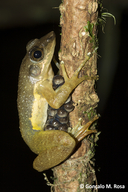|
Description
Adults 41-47 mm. Head characteristically pointed. Tibiotarsal articulation reaches at least the eyes. Hand without webbing, foot extensively webbed: 1(0), 2i(0), 2e(0), 3i(0), 3e(0), 4i/e(0.5-1), 5(0). Dorsal skin smooth to slightly granular. Dorsum usually uniform brown, flanks with a white band. Ventrally uniformly whitish. Males with femoral glands and a slightly distensible single subgular vocal sac (Glaw and Vences 2007). Distribution and Habitat
Country distribution from AmphibiaWeb's database: Madagascar
Occurs in Andringitra (Iantara river; Sahavatoy river), Chaines Anosyennes, Ivohibe, Midongy, near Ifanadiana, Ranomafana (Ambatolahy forest, Maharira forest, Ranomena), Tsianovoha, and Vevembe (Glaw and Vences 2007) from sea level up to 1400 m asl (Cadle and Raxworthy 2008).Life History, Abundance, Activity, and Special Behaviors
Habits: A common species in rainforest streams in south-eastern Madagascar. Quite aquatic, specimens can often be observed in the water during the day. Clutches of about 15 eggs are deposited on leaves overhanging the streams. At night, these clutches are guarded by the male who then sits on the eggs (Glaw and Vences 2007).
Calls: A relatively fast series of about 10 short pulsed notes (Glaw and Vences 2007).
Trends and Threats
This species is listed as least concern because of its wide distribution, presumed large population, and because it is unlikely to be declining fast enough to qualify for listing in a more threatened category. Though it occurs in several protected areas, its forest habitat is receding due to subsistence agriculture, timber extraction, charcoal manufacture, and invasive spread of eucalyptus, livestock grazing and expanding human settlements (Cadle and Raxworthy 2008). Possible reasons for amphibian decline General habitat alteration and loss
Habitat modification from deforestation, or logging related activities
Intensified agriculture or grazing
Urbanization
Comments
Taken with permission from Glaw and Vences (2007) and Cadle and Raxworthy (2008).
References
Cadle, J. and Raxworthy, C. (2008). Mantidactylus majori. In: IUCN 2008. 2008 IUCN Red List of Threatened Species. www.iucnredlist.org. Downloaded on 08 April 2009.
Glaw, F., and Vences, M. (2007). Field Guide to the Amphibians and Reptiles of Madagascar. Third Edition. Vences and Glaw Verlag, Köln.
Originally submitted by: Miguel Vences and Frank Glaw (first posted 2000-12-13)
Edited by: Catherine Aguilar (2009-05-01)Species Account Citation: AmphibiaWeb 2009 Mantidactylus majori <https://amphibiaweb.org/species/4612> University of California, Berkeley, CA, USA. Accessed Apr 19, 2024.
Feedback or comments about this page.
Citation: AmphibiaWeb. 2024. <https://amphibiaweb.org> University of California, Berkeley, CA, USA. Accessed 19 Apr 2024.
AmphibiaWeb's policy on data use.
|
